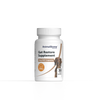As our beloved pets age, they may experience joint pain and stiffness, making it harder for them to move with ease. Dog arthritis and cat arthritis are common conditions that can impact dog mobility and cat mobility, causing discomfort and a decline in their overall quality of life. Just like with aging dogs and aging cats, it's essential to pay attention to their joint health. Promoting dog joint health and cat joint health can make a significant difference in keeping your furry friends active and happy. Simple treatments such as dog massage therapy and cat massage therapy can improve joint flexibility and reduce discomfort, while alternative treatments like Traditional Chinese veterinary medicine can provide relief for conditions like arthritis in dogs.
To learn more about how you can help your aging pet stay mobile and pain-free, watch the full video below where I explain everything you need to know about supporting your pet's joint health and mobility!
The Growing Importance of Mobility in Aging Pets
0:12
For older humans, there’s a lot of focus on relearning movement to improve balance and flexibility. Surprisingly, this is just as relevant for our pets. As they grow older, it’s not uncommon to see them struggle with basic movements, whether it’s jumping on the couch, climbing stairs, or simply walking around the house.
Mobility is essential for maintaining the overall health of your pet. Without it, not only does their physical activity decline, but their mental well-being can also suffer. Older pets, like older humans, benefit greatly from maintaining movement to keep their body functional and sharp.
Why Joint Flexibility is Critical
0:41
Mobility is the ability to move a joint through its normal range of motion. In the case of humans, the hand is a complex joint with multiple directions of motion. Similarly, your dog or cat’s paw connects to a wrist joint, and their elbow joint is also critical for movement.
If your pet loses the full range of motion in these joints, for instance, from 180 degrees down to only 30 degrees, their movement will be greatly restricted. This leads to an unnatural gait, which causes tension in the muscles across their chest, back, and other areas of the body. Over time, this tension “locks down” other parts of their body, making it harder for them to move normally.
The Vicious Cycle of Limited Movement
1:20
When your pet takes small, restricted steps due to joint stiffness, the entire body compensates. Muscle tension starts to build up across different areas, limiting overall flexibility. This limited movement affects the body’s natural mechanics and creates a cycle: the less they move, the more uncomfortable they become, which leads to even less movement.
Fortunately, there are ways to help. This month, I’ll be bringing on Michael Daly, a massage therapist for dogs and cats, who will guide you through ways to help improve your pet’s flexibility and mobility. He’ll share a rough plan to help you get your pet warmed up and ready to move through basic stretches and exercises.
The Connection Between Arthritis and Mobility
2:19
One of the most common causes of limited mobility in pets is arthritis. As arthritis develops, your pet’s ability to move is further restricted, and they begin losing basic daily functions. Tasks like jumping on the sofa, going up and down stairs, or even standing up after lying down become difficult.
The less they move, the more their muscles weaken, and the harder it becomes for them to regain their mobility. This starts a vicious cycle where restricted movement leads to more discomfort and more muscle loss, further compounding the issue.
The Importance of Blood Flow and Movement
2:57
Mobility is not just important for joint health but for overall circulation. Movement increases blood flow to the brain, internal organs, and muscles. This helps maintain muscle mass and keeps the internal systems functioning properly. When movement is restricted, blood flow decreases, leading to cognitive decline and organ dysfunction.
If your pet is becoming less mobile, it’s not only their joints and muscles that are suffering. Reduced mobility can affect their entire system, including their brain and organs, as they receive less oxygen and nutrients.
Traditional Chinese Veterinary Medicine
3:32
In Traditional Chinese Veterinary Medicine (TCVM), there’s a belief that stagnation—whether it’s the stagnation of blood, energy, or movement—leads to disease and discomfort. Lack of movement is one of the factors believed to cause stagnation, which contributes to pain, weakness, and can even lead to serious illnesses like cancer.
Keeping your pet moving regularly helps to prevent stagnation and promotes overall health. Movement is not just about physical strength; it also helps to keep the energy flow in their body balanced, which is an important aspect of TCVM.
How You Can Help Improve Your Pet's Mobility
4:08
If you’ve noticed that your pet’s walks have become shorter, or they seem to be struggling with mobility, the best thing to do is to start small. For instance, if your pet is only walking for a few minutes a day, try adding just a couple of extra minutes to their routine.
Over time, these small adjustments can lead to improved mobility and help maintain their muscle mass. Don’t rush the process—allow them to gradually increase their activity level.
That’s all for now! We’ll dive deeper into mobility tips in next week’s post, including ways to improve joint flexibility and balance in your older pets. We’ll also cover a question I received recently about hemorrhagic bowel syndrome, which I’ll answer below in the comments.
Thank you for tuning in, and remember—keep your pets moving for a healthier, happier life!
Cheers!















